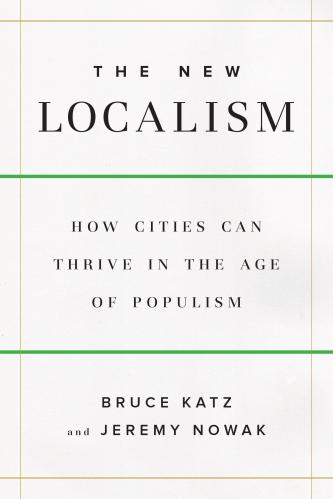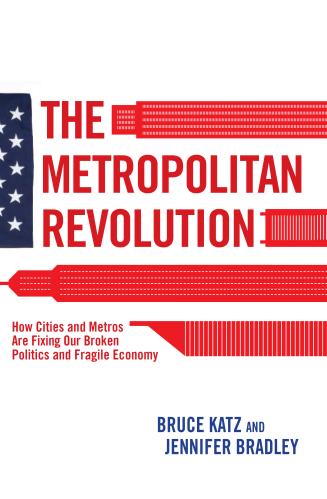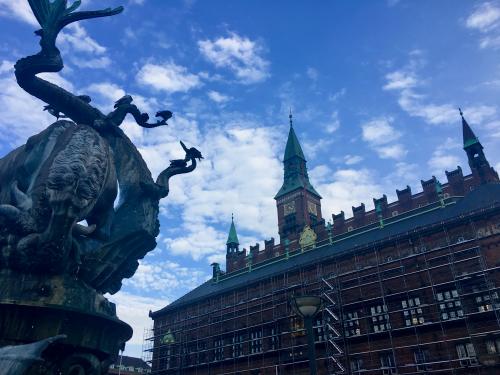Although problem solvers congregate at the city and metropolitan scale, few chronicle their big challenges and successes. Dan Doctoroff, currently CEO of Google’s Sidewalk Labs, is a notable exception. He came to Brookings last week to discuss his new book, Greater than ever: New York’s big comeback. Written ten years after leaving his position as Mike Bloomberg’s deputy mayor of economic development, the book is a riveting recollection of how New York City pushed forward in the aftermath of 9/11.
It is also a handbook for other leaders who embrace New Localism—the reality that power is shifting down to cities, and horizontally across the networks of public, private and civic leaders that naturally govern them. Doctoroff’s memoir emphasizes the importance of rethinking how we solve problems in our cities and, in the process, create new norms of urban growth, governance, and finance in a locally-led world.
Growth
“In order to be a progressive city, a city must be prosperous. In order to be a prosperous city, a city must grow.” Doctoroff opened by sharing his virtuous cycle of growth: a city must experience growth to be prosperous and a growing city indicates leaders are taking effective actions to leverage their community’s distinctive assets and advantages.
Doctoroff went on to say that leaders must ensure they are accommodating growth effectively, in New York City’s case that meant population growth and the need for more affordable housing. To set the platform for growth, the Bloomberg administration introduced a historic $3 billion commitment to building sixty-five thousand units of affordable housing across the city during their initial three months in office.
Doctoroff argues that the most important metric of a city’s health is population growth, stating that the cycle of growth continues when more people choose New York over other places to live. To support this growth, the Bloomberg administration invested directly in agencies responsible for quality of life. Over three terms in office, spending increased 54 percent from a $42 billion operating budget in 2003 to $70 billion in 2014. New investments in safety, education, health, transportation, housing, and more were made, improving the quality of life for all New Yorkers, while feeding the virtuous cycle of growth.
Governance
“Getting things done was three times harder for every state agency involved; 10 times harder for every federal agency involved; and infinitely harder if the [NY/NJ] Port Authority was involved.” During his talk, he used his failed effort to pass congestion pricing as an example of the lack of state support for the city. While popular among city residents and with the potential to fund critical infrastructure projects, an overly interventionist state legislature put an end to it. However, Doctoroff did note that his team made every effort to involve the community in its projects, specifically citing the rezoning process for the Highline as an example. What Doctoroff calls his “theorem of getting things done in government” shows the importance of cities using the powers that they have to get stuff done.
Doctoroff needed new tools to govern and tackle the many challenges he faced when he entered office, especially when it came to the development of land. To combat an acute housing problem, lack of land or property upon which to create affordable housing, and the city’s lack of funding, Doctoroff and his team embarked on the largest rezoning effort since the code was last updated in 1961. At that time there were 847,000 manufacturing jobs in the city. In 2002, the number of manufacturing jobs had fallen to about 140,000.
Ultimately, over twelve years the Bloomberg administration would propose 140 separate zoning actions, covering 40 percent of the city. This led to the creation of new tools to facilitate the acquisition and development of land. Examples include the reform of brownfield remediation laws; creation of a revolving credit facility to help small developers acquire property for affordable housing; and the use of inclusionary zoning.
Finance
“There is money for every city lying all over the place, you just have to go find it and be creative. We found it in the air, we found it in future taxes, we found it in the value of the sidewalks and in the value of the streets.” Bloomberg’s administration knew they wouldn’t succeed if they couldn’t find ways to finance major projects in the city—and help wasn’t coming from the state or feds. To advance the Highline on Manhattan’s West Side, they were able to create money out of thin air. By creating air rights for properties under the railway, up-zoning land along the future park, and formalizing a market to buy and sell the air rights between the respective owners, the city was able to bring all parties involved to the table without public dollars. The result has been massive redevelopment around a new public space that is now frequented by more than eight million people each year, winning numerous awards for environmental design.
Another example cited by Doctoroff is Hudson Yards, a large development project built above 28 acres of railyards and financed through the creation of the nation’s largest Tax Increment Financing (TIF) district. TIF allows cities to capture the increase in local property tax revenues from new development within a defined geographic area for a specific period of time without approval of the other taxing jurisdictions. It is a tool that cities, counties, economic development authorities (EDAs), port authorities, and housing and redevelopment agencies (HRAs) can use to spur private development.
We know that cities have public assets such as airports, parking lots, and convention centers at their disposal; it is just a matter of putting them to use and leveraging their earning potential to reinvest in the community and local needs. I have written that governments do not, for the most part, manage their public wealth well, failing to leverage the market potential and value of the assets they own. This builds on the work of Dag Detter and Stefan Folster in their book The Public Wealth of Cities where Dan Doctoroff recently wrote the foreword emphasizing that public wealth is valuable to us all. In the case of New York, Doctoroff shows how smart public finance decisions allowed the city to successfully leverage these assets.
Great conversation with @DanDoctoroff as he shared his theorem on spurring action in government: https://t.co/6u5ePOsk7F #NewLocalism pic.twitter.com/v8Suws5kR8
— Bruce Katz (@bruce_katz) November 3, 2017









Commentary
New York City and new localism: The Doctoroff theory of change
November 6, 2017